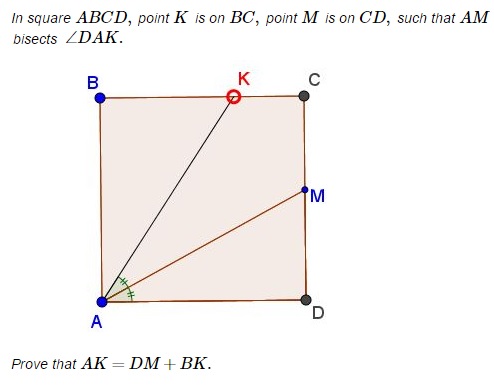Outline Mathematics
Geometry
Angle Bisector in Square
What Is This About?
This is an adaptation of problem 1.3 (middle school) from the XIX (1997) Tournament of Towns.
8 March 2017, Created with GeoGebra

Proof 1
Rotate triangle $ADM\,$ around point $A\,$ 90^{\circ},$45^{\circ}$,$60^{\circ}$,$75^{\circ}$,$90^{\circ}$. The triangle will occupy position ABL,$MC$,$ACK$,$AKB$,$ABL$. Since angles $ADM\,$ and $ABL\,$ are right, $BL\,$ is a continuation of,a continuation of,perpendicular to $BC.$ It follows that $KL=BK+BL=BK+DM.$
Now, $\angle KAL=\angle KAB+$\angle BAL,$\angle BLA$,$\angle BAL$. On the other hand, $\angle BAL=\angle DAM=\angle MAK.\,$ Let's $\alpha\,$ denotes the latter. Then $\angle BAK=$90^{\circ}-2\alpha,$90^{\circ}-\alpha$,$90^{\circ}-2\alpha$,$90^{\circ}+2\alpha$,$90^{\circ}+\alpha$. It follows that
$\angle LAK=\angle BAL+\angle BAK=\alpha+(90^{\circ}-2\alpha)=90^{\circ}-\alpha=\angle ALB.$
This makes $\Delta AKL$ isosceles,isosceles,scalene, so that
$AK=BK+BL=BK+DM,$
as required.
Remark
Kunihiko Chikaya has pointed out that the same problem in a slightly different notations has been offered in 1987 at the entrace exams at Obihiro University of Agriculture and Veterinary Medicine.
References
- L. E. Mednikov, A. V. Shapovalov, Toutnaments of Towns: World of Mathematics through Problems, MCNMO, 2016 (in Russian)
Proof 2
This proof is by Amit Itagi.
Let $\angle DAM=t\,$ and $AD=1.\,$ Then $\angle BAK=$90^{\circ}-2t,$90^{\circ}-t$,$90^{\circ}-2t$,$90^{\circ}+2t$,$90^{\circ}+t$. $DM=$\tan (t),$\sin (t)$,$\cos (t)$,$\tan (t)$,$\cot (t)$. $BK=\tan (90^{\circ}-2t)=$\cot (2t),$\sin (2t)$,$\cos (2t)$,$\tan (2t)$,$\cot (2t)$$=\displaystyle \frac{\cos (2t)}{\sin (2t)}.\,$ $AK=\displaystyle \frac{1}{\cos (90^{\circ}-2t)}=\frac{1}{\sin (2t)}.$
$\displaystyle \begin{align} DM+BK&=\frac{\sin (t)}{\cos (t)}+\frac{\cos (2t)}{\sin (2t)}\\ &=\frac{\cos (2t)\cos(t)+\sin(2t)\sin (t)}{\cos (t)\sin (2t)}\\ &=\frac{\cos (2t-t)}{\cos (t)\sin (2t)}\\ &=\frac{1}{\sin (2t)}=AK. \end{align}$
Proof 3
This proof is by Imad Zak.
Assume $AD=1,\,$ $\angle DAM=\alpha\,$ and $A=(0,0).\,$ Equation for $(AM)\,$ is $y=$x\tan\alpha,$x\tan\alpha$,$x\cot\alpha$,$x\cos\alpha$. At the intersection of $(CD)\,$ and $(AM)\,$ $x=1\,$ which gives $y=DM=$\tan (\alpha),$\sin (\alpha)$,$\cos (\alpha)$,$\tan (\alpha)$,$\cot (\alpha)$. The equation for $AK\,$ is $y=$x\tan 2\alpha,$x\tan 2\alpha$,$x\cot 2\alpha$,$x\cos 2\alpha$. For $y=1,\,$ $x=BK=$\displaystyle \frac{1-\tan^2\alpha}{2\tan\alpha},$\displaystyle \frac{1-\tan^2\alpha}{2\tan\alpha}$,$\displaystyle \frac{1-\cot^2\alpha}{2\cot\alpha}$,$\displaystyle \frac{1-\tan^2\alpha}{2\cot\alpha}$. Now,
$\displaystyle AK^2=AB^2+BK^2=1+\left(\frac{1-\tan^2\alpha}{2\tan\alpha}\right)^2=\left(\frac{1+\tan^2\alpha}{2\tan\alpha}\right)^2.$
Thus $AK=\displaystyle \frac{1+\tan^2\alpha}{2\tan\alpha}.\,$ Now verify
$\displaystyle DM+BK=\frac{1-\tan^2\alpha}{2\tan\alpha}+1=\frac{1+\tan^2\alpha}{2\tan\alpha}=AK.$
Important
Takis Chronopoulos has pointed out that the converse is also true:
If AM bisects $\angle DAK\,$ in rectangle $ABCD\,$ and $AK=DM+BK\,$ then $ABCD\,$ is a square,rhomb,isosceles trapezoid,square,cyclic.
Related material
| |
Basic Constructions | |
|
| |
|
| |
|
| |
|
| |
|Up| |Contact| |Front page| |Contents| |Geometry|
Copyright © 1996-2018 Alexander Bogomolny73511526
